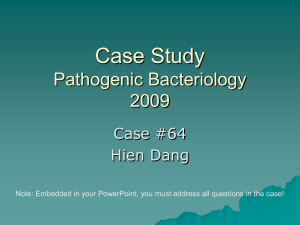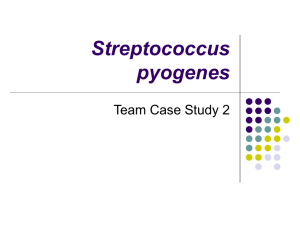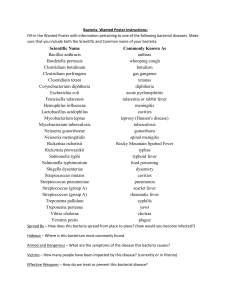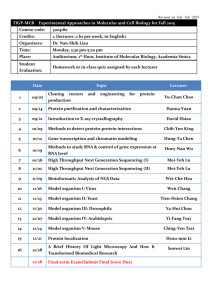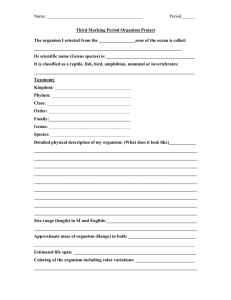MICROBIOLOGY 302 - Cal State LA
advertisement
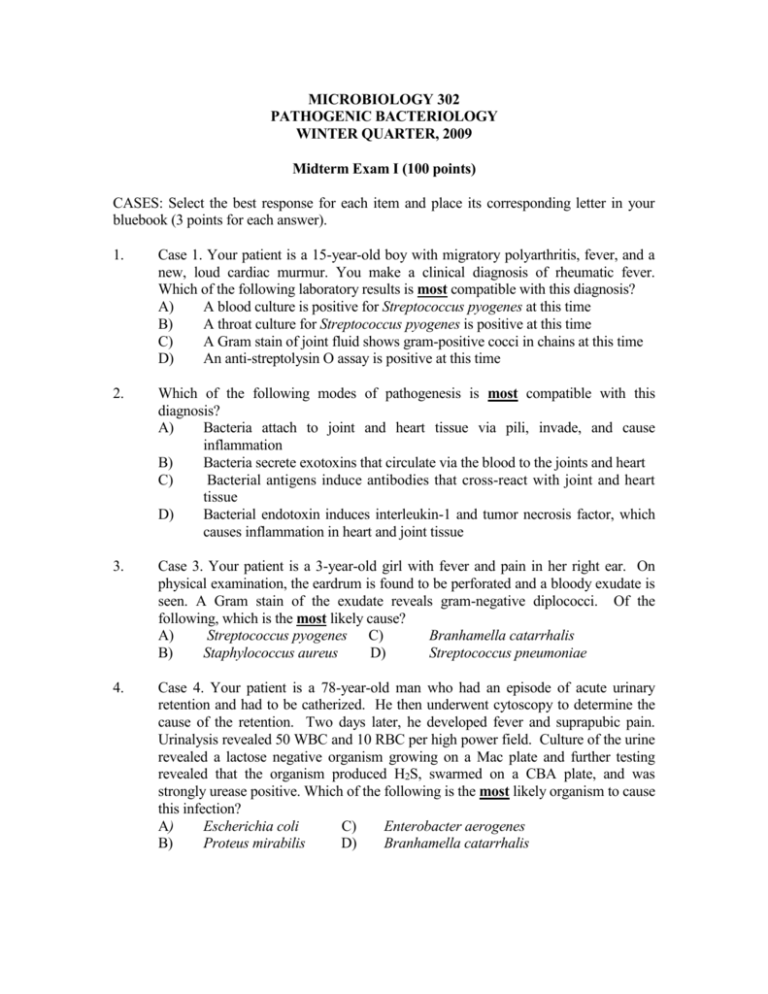
MICROBIOLOGY 302 PATHOGENIC BACTERIOLOGY WINTER QUARTER, 2009 Midterm Exam I (100 points) CASES: Select the best response for each item and place its corresponding letter in your bluebook (3 points for each answer). 1. Case 1. Your patient is a 15-year-old boy with migratory polyarthritis, fever, and a new, loud cardiac murmur. You make a clinical diagnosis of rheumatic fever. Which of the following laboratory results is most compatible with this diagnosis? A) A blood culture is positive for Streptococcus pyogenes at this time B) A throat culture for Streptococcus pyogenes is positive at this time C) A Gram stain of joint fluid shows gram-positive cocci in chains at this time D) An anti-streptolysin O assay is positive at this time 2. Which of the following modes of pathogenesis is most compatible with this diagnosis? A) Bacteria attach to joint and heart tissue via pili, invade, and cause inflammation B) Bacteria secrete exotoxins that circulate via the blood to the joints and heart C) Bacterial antigens induce antibodies that cross-react with joint and heart tissue D) Bacterial endotoxin induces interleukin-1 and tumor necrosis factor, which causes inflammation in heart and joint tissue 3. Case 3. Your patient is a 3-year-old girl with fever and pain in her right ear. On physical examination, the eardrum is found to be perforated and a bloody exudate is seen. A Gram stain of the exudate reveals gram-negative diplococci. Of the following, which is the most likely cause? A) Streptococcus pyogenes C) Branhamella catarrhalis B) Staphylococcus aureus D) Streptococcus pneumoniae 4. Case 4. Your patient is a 78-year-old man who had an episode of acute urinary retention and had to be catherized. He then underwent cytoscopy to determine the cause of the retention. Two days later, he developed fever and suprapubic pain. Urinalysis revealed 50 WBC and 10 RBC per high power field. Culture of the urine revealed a lactose negative organism growing on a Mac plate and further testing revealed that the organism produced H2S, swarmed on a CBA plate, and was strongly urease positive. Which of the following is the most likely organism to cause this infection? A) Escherichia coli C) Enterobacter aerogenes B) Proteus mirabilis D) Branhamella catarrhalis 5. Case 5. Your patient is a 10-year-old boy who fell, abraded the skin of his thigh, and developed cellulitis. Several days later, the infection was treated with a topical antibiotic ointment and the cellulitis gradually healed. However, 2 weeks later, he told his mother that his urine was cloudy and reddish, and she noted that his face was swollen. You suspect acute glomerulonephritis. Regarding the causative organism, what is the most likely appearance of the Gram stain of the exudate from the original skin infection? A) Gram-positive cocci in grapelike clusters B) Gram-positive cocci in chains C) Gram-positive diplococci D) Gram-negative diplococci 6. What is the pathogenesis of the cloudy urine and facial swelling? A) Toxin mediated B) Direct invasion by the bacteria C) Immune-complex mediated D) Cell-mediated immunity (delayed hypersensitivity) MULTIPLE CHOICE: Select the best response for each item and place its corresponding letter in your bluebook (2 points each). 1. The toxigenic diseases caused by Staphylococcus aureus include A) food poisoning D) toxic shock syndrome B) scarlet fever E) two of these C) scalded skin syndrome F) three of these G) all of these 2. The classification of Streptococci into Lancefield groups is dependent upon the presence of group specific A) M antigens D) K antigens B) C-substance antigens E) H antigens C) O antigens 3. The beta-hemolytic reactions produced by Group A Streptococci on blood agar incubated under aerobic conditions are the result of the action of A) Streptolysin O D) two of these B) Streptolysin S E) all of these C) Streptokinase 4. A smooth to rough colonial morphology often seen in clinical isolates may be correlated with A) decreased virulence D) loss of H antigen B) loss of capsule E) two of these C) loss of O antigen F) three of these G) all of these 5. Biochemical reactions of an organism are consistent with Salmonella. A suspension is tested in polyvalent antiserum without resulting agglutination. However, after 15 minutes of boiling, agglutination occurs in polyvalent and group specific antisera. This indicates that A) organism contains a blocking O antigen B) organism contains a blocking K antigen C) the antiserum was of low potency E) none of these would explain the results TRUE-FALSE: Print true or false in your bluebook for each of the statements below (2 points each): 1. Cultures for Streptococcus pneumoniae and Neisseria gonorrhoeae should be refrigerated if they cannot be planted immediately. 2. Patients with gonorrhea commonly have a concomitant infection with Chlamydia trachomatis. 3. In bubonic plague, transmission is from human to human. 4. It is common for a woman with GC infection to be unaware of the infection until she develops PID. 5. Unlike the pneumonia caused by many other organisms, the pneumonia caused by Klebsiella pneumoniae frequently results in permanent lung damage. 6. The infective dose for Shigella is > 103 organisms/ ml. FILL-INS: Print the correct answer in your blue book. For organisms requested, print the entire genus and species. (2 points each.) 1. Name an organism that produces an IgA protease. 2. Name one of the two organisms most likely to cause neonatal meningitis. 3. Name the virulence factor, produced by Staphylococcus aureus, that binds to the Fc portion of IgG. 4. Name the major virulence factor of Streptococcus pyogenes for which antibodies are type specific and protective. 5. Name one characteristic common to strains of Neisseria gonorrhoeae that cause disseminated infections. 6. Name the "hallmark" symptom of meningitis caused by Neisseria meningitidis? 7. Name the major virulence factor of Streptococcus pneumoniae for which antibodies are type specific and protective. 8. Name an organism that has H antigens that occur in two phases. 9. Name the group of organisms that most commonly cause subacute bacterial endocarditis. 10. Name the virulence factor that acts like a molecular syringe to directly inject toxins into host cells. Name the best media for the selective isolation of the following organisms: 11. Yersinia enterocolitica 12. E. coli O157 H7 13. Staphylococcus aureus 14. Streptococcus pyogenes 15. Neisseria meningitidis SHORT ESSAYS: Answer one of the following two essay questions in your bluebook (10 points). 1. Compare and contrast the structure and mode of action of the E. coli ST enterotoxin and the E. coli LT enterotoxin, 2. Compare and contrast the attachment, invasion, and disease caused by Shigella species and Salmonella species. LONG ESSAYS: Answer one the following two essay questions in your bluebook (20 points) 1. Compare and contrast the five different types of E. coli that cause gastroenteritis. Include a discussion of the virulence factors and the type of disease caused by each. 2. Discuss the two types of disease caused by Neisseria meningitidis. In your discussion include the major virulence factors and how they contribute to the symptoms of the infected host.


